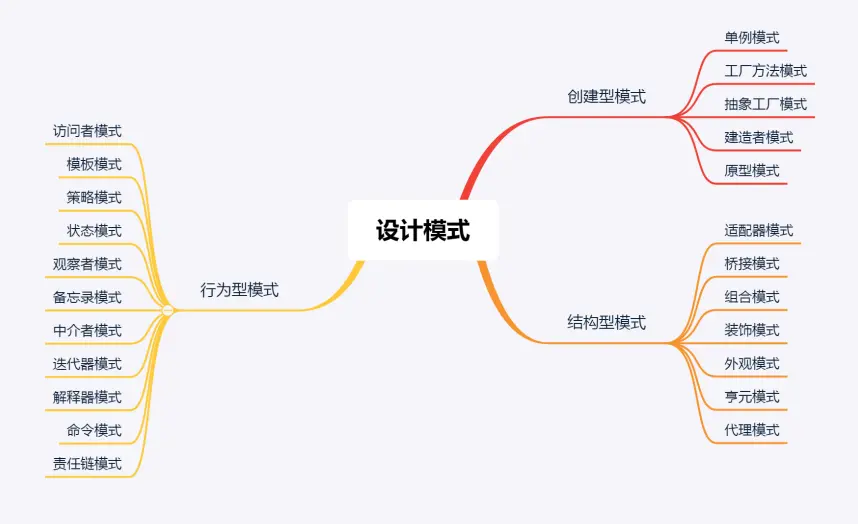 设计模式 13 问
设计模式 13 问
# 设计模式 13 问
# 1、谈谈你对设计模式的理解?
设计模式是一种被广泛应用的解决问题的经验总结,它提供了一套可复用、可扩展、易于维护的解决方案。设计模式可以帮助我们更好地组织代码,提高代码质量和可读性。
我将他理解成是一种由以前的程序员在实际工作中反复使用,总结得出的经验,最终形成的使用的模式。
有 7 个常用的软件设计原则
开闭原则 -- 对扩展开放,对修改关闭
单一职责原则 -- ⼀个类只负责⼀个功能领域中的相应职责
里氏替换原则 -- 所有引用基类的地方必须能透明地使用其子类的对象
依赖倒置原则 -- 依赖于抽象,不能依赖于具体实现
接口隔离原则 -- 类之间的依赖关系应该建立在最小的接口上
合成/聚合复用原则 -- 尽量使用合成/聚合,而不是通过继承达到复用的目的
最少知识原则 或者 迪米特法则 -- 一个软件实体应当尽可能少的与其他实体发生相互作用
主要有三大分类
- 创建型模式
- 结构型模式
- 行为型模式
![image]()
# 2、谈谈你对工厂方法模式的理解?
工厂方法模式是一种创建型设计模式,它将对象的创建委托给子类,由子类决定实例化哪个类。这样可以将对象的创建与使用分离,提高了代码的可扩展性和灵活性。
interface Product {
void show();
}
class ConcreteProduct implements Product {
@Override
public void show() {
System.out.println("具体产品");
}
}
abstract class Factory {
public abstract Product createProduct();
}
class ConcreteFactory extends Factory {
@Override
public Product createProduct() {
return new ConcreteProduct();
}
}
// 在客户端代码中使用
public static void main(String[] args) {
Factory factory = new ConcreteFactory();
Product product = factory.createProduct();
product.show(); // 输出:具体产品
}
2
3
4
5
6
7
8
9
10
11
12
13
14
15
16
17
18
19
20
21
22
23
24
25
26
27
28
# 3、谈谈你对简单工厂模式的理解?
简单工厂模式是一种创建型设计模式,它通过一个工厂类来创建对象,而不是直接在客户端代码中实例化对象。简单工厂模式简化了对象的创建过程,对客户端隐藏了对象的创建细节。
interface Product {
void show();
}
class ConcreteProductA implements Product {
@Override
public void show() {
System.out.println("产品A");
}
}
class ConcreteProductB implements Product {
@Override
public void show() {
System.out.println("产品B");
}
}
class SimpleFactory {
public static Product createProduct(String type) {
if ("A".equals(type)) {
return new ConcreteProductA();
} else if ("B".equals(type)) {
return new ConcreteProductB();
} else {
throw new IllegalArgumentException("无效的产品类型");
}
}
}
// 在客户端代码中使用
public static void main(String[] args) {
Product productA = SimpleFactory.createProduct("A");
Product productB = SimpleFactory.createProduct("B");
productA.show(); // 输出:产品A
productB.show(); // 输出:产品B
}
2
3
4
5
6
7
8
9
10
11
12
13
14
15
16
17
18
19
20
21
22
23
24
25
26
27
28
29
30
31
32
33
34
35
36
37
# 4、谈谈你对单例模式的理解?
单例模式是一种创建型设计模式,它确保一个类只有一个实例,并提供一个全局访问点。单例模式通常用于管理全局资源或控制某些共享资源的访问。
class Singleton {
private static Singleton instance;
private Singleton() {
// 私有构造方法
}
public static Singleton getInstance() {
if (instance == null) {
instance = new Singleton();
}
return instance;
}
}
// 在客户端代码中使用
public static void main(String[] args) {
Singleton singleton = Singleton.getInstance();
// 使用singleton对象进行操作
}
2
3
4
5
6
7
8
9
10
11
12
13
14
15
16
17
18
19
20
# 5、谈谈你对代理模式的理解?
代理模式是一种结构型设计模式,它通过一个代理类来控制对另一个对象的访问。代理模式可以用于实现延迟加载、权限控制、远程访问等功能。
interface Subject {
void request();
}
class RealSubject implements Subject {
@Override
public void request() {
System.out.println("真实主题");
}
}
class Proxy implements Subject {
private RealSubject realSubject;
@Override
public void request() {
if (realSubject == null) {
realSubject = new RealSubject();
}
System.out.println("代理前处理");
realSubject.request();
System.out.println("代理后处理");
}
}
// 在客户端代码中使用
public static void main(String[] args) {
Subject proxy = new Proxy();
proxy.request();
}
2
3
4
5
6
7
8
9
10
11
12
13
14
15
16
17
18
19
20
21
22
23
24
25
26
27
28
29
30
# 6、谈谈你对模板模式的理解?
模板模式是一种行为型设计模式,它定义了一个算法的骨架,将一些步骤的具体实现延迟到子类中。模板模式可以提高代码的复用性和可扩展性。
abstract class AbstractClass {
public void templateMethod() {
// 一些公共的处理逻辑
specificMethod();
// 一些其他的公共处理逻辑
}
protected abstract void specificMethod();
}
class ConcreteClass extends AbstractClass {
@Override
protected void specificMethod() {
System.out.println("具体子类实现");
}
}
// 在客户端代码中使用
public static void main(String[] args) {
AbstractClass abstractClass = new ConcreteClass();
abstractClass.templateMethod();
}
2
3
4
5
6
7
8
9
10
11
12
13
14
15
16
17
18
19
20
21
22
# 7、谈谈你对观察者模式的理解?
观察者模式是一种行为型设计模式,它定义了一种一对多的依赖关系,当一个对象状态发生改变时,它的所有依赖者都会收到通知。观察者模式可以用于实现事件监听、消息订阅等功能。
interface Observer {
void update(String message);
}
class ConcreteObserver implements Observer {
@Override
public void update(String message) {
System.out.println("收到消息:" + message);
}
}
class Subject {
private List<Observer> observers = new ArrayList<>();
public void addObserver(Observer observer) {
observers.add(observer);
}
public void removeObserver(Observer observer) {
observers.remove(observer);
}
public void notifyObservers(String message) {
for (Observer observer : observers) {
observer.update(message);
}
}
}
// 在客户端代码中使用
public static void main(String[] args) {
Subject subject = new Subject();
Observer observer1 = new ConcreteObserver();
Observer observer2 = new ConcreteObserver();
subject.addObserver(observer1);
subject.addObserver(observer2);
subject.notifyObservers("Hello, observers!");
}
2
3
4
5
6
7
8
9
10
11
12
13
14
15
16
17
18
19
20
21
22
23
24
25
26
27
28
29
30
31
32
33
34
35
36
37
38
39
40
# 8、谈谈你对装饰器模式的理解?
装饰器模式是一种结构型设计模式,它动态地给一个对象添加一些额外的功能,而不影响其接口。装饰器模式可以用于扩展一个类的功能,而不需要修改其原始代码。
interface Component {
void operation();
}
class ConcreteComponent implements Component {
@Override
public void operation() {
System.out.println("具体组件");
}
}
abstract class Decorator implements Component {
protected Component component;
public Decorator(Component component) {
this.component = component;
}
@Override
public void operation() {
component.operation();
}
}
class ConcreteDecorator extends Decorator {
public ConcreteDecorator(Component component) {
super(component);
}
@Override
public void operation() {
super.operation();
System.out.println("装饰器扩展功能");
}
}
// 在客户端代码中使用
public static void main(String[] args) {
Component component = new ConcreteComponent();
Component decorator = new ConcreteDecorator(component);
decorator.operation();
}
2
3
4
5
6
7
8
9
10
11
12
13
14
15
16
17
18
19
20
21
22
23
24
25
26
27
28
29
30
31
32
33
34
35
36
37
38
39
40
41
42
# 9、谈谈你对策略模式的理解?
策略模式是一种行为型设计模式,它定义了一系列算法,并使它们可以相互替换,让算法的变化独立于使用算法的客户端。策略模式可以提高代码的灵活性和可维护性。
interface Strategy {
void algorithm();
}
class ConcreteStrategyA implements Strategy {
@Override
public void algorithm() {
System.out.println("具体策略A");
}
}
class ConcreteStrategyB implements Strategy {
@Override
public void algorithm() {
System.out.println("具体策略B");
}
}
class Context {
private Strategy strategy;
public Context(Strategy strategy) {
this.strategy = strategy;
}
public void execute() {
strategy.algorithm();
}
}
// 在客户端代码中使用
public static void main(String[] args) {
Strategy strategyA = new ConcreteStrategyA();
Strategy strategyB = new ConcreteStrategyB();
Context contextA = new Context(strategyA);
Context contextB = new Context(strategyB);
contextA.execute(); // 输出:具体策略A
contextB.execute(); // 输出:具体策略B
}
2
3
4
5
6
7
8
9
10
11
12
13
14
15
16
17
18
19
20
21
22
23
24
25
26
27
28
29
30
31
32
33
34
35
36
37
38
39
40
41
# 10、谈谈你对适配器模式的理解?
适配器模式是一种结构型设计模式,它将一个类的接口转换成客户端所期待的接口,使得原本不兼容的类可以协同工作。适配器模式可以用于解决不同接口之间的兼容性问题。
interface Target {
void request();
}
class Adaptee {
public void specificRequest() {
System.out.println("适配者的方法");
}
}
class Adapter implements Target {
private Adaptee adaptee;
public Adapter(Adaptee adaptee) {
this.adaptee = adaptee;
}
@Override
public void request() {
adaptee.specificRequest();
}
}
// 在客户端代码中使用
public static void main(String[] args) {
Adaptee adaptee = new Adaptee();
Target target = new Adapter(adaptee);
target.request();
}
2
3
4
5
6
7
8
9
10
11
12
13
14
15
16
17
18
19
20
21
22
23
24
25
26
27
28
29
# 11、谈谈 IO 中用到的设计模式?
在IO中,常用的设计模式包括装饰器模式(例如BufferedInputStream)、观察者模式(例如Java IO的事件监听器)、适配器模式(例如InputStreamReader)等。
InputStream inputStream = new FileInputStream("file.txt");
inputStream = new BufferedInputStream(inputStream);
inputStream = new DataInputStream(inputStream);
// 在这里,BufferedInputStream 和 DataInputStream 就是装饰器,通过组合方式给 FileInputStream 添加了缓冲和处理基本数据类型的功能。
2
3
4
# 12、谈谈 Spring 中用到的设计模式?
在Spring中,常用的设计模式包括单例模式(例如Spring容器管理Bean的单例实例)、模板模式(例如JdbcTemplate)、代理模式(例如AOP实现)等。
// IoC示例
@Service
public class MyService {
private MyRepository repository;
@Autowired
public MyService(MyRepository repository) {
this.repository = repository;
}
// ...
}
// AOP示例
@Aspect
@Component
public class MyAspect {
@Before("execution(* com.example.MyService.*(..))")
public void beforeAdvice() {
System.out.println("执行前置通知");
}
}
2
3
4
5
6
7
8
9
10
11
12
13
14
15
16
17
18
19
20
21
22
# 13、谈谈 MyBatis 中用到的设计模式?
在MyBatis中,常用的设计模式包括工厂模式(例如SqlSessionFactoryBuilder用于创建SqlSessionFactory)、模板模式(例如BaseExecutor中定义SqlSession的模板方法)等。
SqlSessionFactory factory = new SqlSessionFactoryBuilder().build(inputStream);
SqlSession session = factory.openSession();
// Mapper接口代理示例
MapperInterface mapper = session.getMapper(MapperInterface.class);
2
3
4
5

